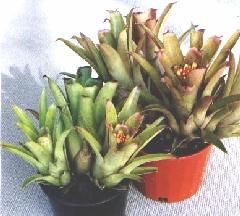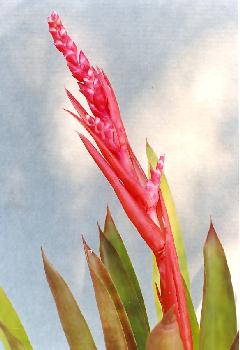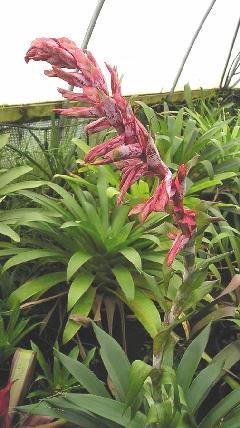

Peter Franklin |
Pamela Koide |
Coming Events.
Sept 9th Aechmea recurvata and its hybrids
Oct 14th Neoregelia olens and its hybrids
Nov 10th 10am to 4pm Special Sales day open to Public
Nov 11th Start 1.30pm. Plant swap and auction. Special afternoon tea. Bring a plate!
July meeting from the Secretary’s desk.
Thanks to Jeanne Hall we now have a stock of the book entitled Bromeliaceae – Names and synonyms to be sold at $12 or $20 when postage is required within Australia. This implies a weighty book, which it is at 185 A4 pages! Why do we have such a book? At the May meeting I brandished a looseleaf folder I had compiled of Bromeliad names from the past say 300 years which I felt would help me when I talked about Latin names. For some reason there was interest in these many pages and Jeanne volunteered to print some for us – as a trial run. To understand the list of names you must read page one FIRST! It is planned to do new copies every two years because regrettably taxonomists are always changing their minds. It is written in Aussie English and it has been offered to the BSI if they want to publish in American in the USA and to Die Bromelie in case they want to publish in German!
Stone the Crows! Hon Pres was back after missing two meetings so we got him busy.
We had 30 people in attendance according to our head count expert, which was great for wintry weather. Having a billiard table in the middle of our ‘normal’ meeting room has made us appreciate what we have in the main hall so we spent most of our time there.
There were several plants brought in for discussion and Len Colgan was given carte blanche. First was Aechmea ‘Covata Too’ which has an interesting history that new members might like to know about and which older serving members have forgotten. Over 20 years ago some Californian crossed Aechmea recurvata v ortgiesii or var. benrathii with Aechmea comata and cleverly named it Aechmea ‘Covata’ and in 1982 I proudly brought back a plant to Adelaide. Meanwhile, also in California someone had crossed Aechmea recurvata v. recurvata with Aechmea comata and cleverly named it Aechmea ‘Covata’ too! The problem here was that the first hybrid has an inflorescence nestled in the leaf rosette and the second hybrid had an inflorescence well exceeding the leaf rosette. On enquiry in the late 1990’s nobody in California had the ‘Covata’ with the sunken inflorescence but everybody seemed to be growing the one with the emergent flower head possibly because Pam Koide was selling it. I knew that the Californians would never change the name so the Adelaide version got named ‘Covata Too’. Not very subtle I admit but at least a solution. Apart from our own Keith Bradtberg producing ‘Keith’s Comet’ this particular parentage has been tried by other hybridists without registering, to add to the confusion. On the one hand I enjoy investigating problems caused by hybridists not registering their hybrids but on the other their sheer volume gets me annoyed. Registration of hybrids is so easy that there is no excuse other than laziness and a big ego.


Peter Franklin |
Pamela Koide |
Len then showed us digital photos of his trip last year to the World Conference in San Diego and he supplied the following notes.
In 2006, Len Colgan and his brother undertook a six week driving tour of the USA, followed by eight days in Germany. Len had been invited to give two talks at the BSI World Bromeliad Conference in San Diego, and this occupied the middle week of his time away. During the whole trip, Len took a lot of digital photographs of the places they visited. These included a number of pictures featuring bromeliads, which were converted into a Powerpoint presentation for the final part of the meeting.
The talk began with images taken at the Huntington Botanical Gardens in Los Angeles, California. Amongst a panorama of large cacti and succulents, we saw massive expanses of terrestrial bromeliads, mainly deuterocohnia, puya and dyckia. Unfortunately, Len did not record all of the species names, but some of the highlights included colonies of Deutercohnia lorentziana and Deutercohnia brevifolia.
Puya alpestris is a stunner when in full flower, but the most audible gasps from the members corresponded to Puya venusta. There were vast colonies of these large plants with silver-grey leaves. But dozens were in flower with tall branched bright red inflorescences covered with large blue flowers displaying prominent yellow stamens. Truly spectacular! Many other puya and dyckia colonies were also in flower.
The next long set of pictures was taken in the collection of John Arden, at whose home Len was fortunate to stay before the BSI Conference. John lives in Vista, California, and is one of the world’s foremost hybridizers of Vrieseas, and to a lesser extent, Tillandsias. His creations have won numerous awards, including the Grand Champion at the San Francisco conference in 2000. John’s dream is to create the ultimate vriesea, which would have very dark purple leaves and a large compound inflorescence displaying shades of bright red, orange and yellow. As we saw, he is not far from achieving that goal. Len mentioned that he was thrilled to obtain one bigeneric vrieslandsia, created many years ago when John applied pollen from various vrieseas to different branches of Tillandsia superinsignis. Now we must wait to see how it fares here in Adelaide.
Len’s next visit was to the new nursery of Pamela Koide. The first picture was of a clump of Tillandsia sucrei with four beautiful flower spikes. Then there were two pictures of Pam herself, proudly showing off flowering T. australis and T. pamelae.
Next came a number of display and show plants at the World Conference, including many of the prize winners. Len mentioned that he had donated professionally produced copies of about 100 original coloured prints from the late 1800s. This was acknowledged in the conference program handbook, but Len was thrilled to see that they had been framed to create all of the show’s prizes. Of special interest was a pair of flowering Billbergia alfonsi-johannis which won the Grand Champion (Horticulture) award, and was entered by the BSI president herself, Joyce Brehm. Amongst many pictures taken at the conference, some most worthy of mention were massive clumps of flowering T. tectorum and T. streptophylla, a clump of Billbergia ‘Hallelujah’, and a spectacular variegated Neoregelia involving N. ‘Hannibal Lector’.
Lydia Koehres’s nursery is south of Frankfurt in Germany. It contains many rare tillandsias, almost all of which were collected in the wild. In fact the plants are so rare that neither Len nor the secretary were able to identify many of those in flower. But at least we could all drool and dream. However, some of them most probably would not survive Australia’s quarantine treatment, let alone our climate. Nevertheless, Len is hoping that his selective purchases will maintain their current healthy state.
Finally, we saw a number of tillandsias in flower in the private collection of Renate Ehlers, with whom Len stayed for eight days in Stuttgart. These included T. macdougallii, T. lampropoda, T. cretacea, as well as Vriesea incurva. Again, Len failed to record the names of other plants, a fault which he must remedy in future trips abroad!
Vale - Len Cork
Len died at Queen Elizabeth Hospital on 17th July. Our condolences go out to Gloria who always seemed to be around when Len was there – were they Siamese twins?
My contact with ‘The Corks’ goes back over 40 years when Len was into Cactus and all things prickly.
I well remember the time when on one of the many coachtours we went on and Margaret had made the family favourite to eat cold – Cheese and onion pie. Such was the aroma that both Len & Gloria sitting behind, complained bitterly that there was no slice for them!
Who can recall Len growing what he thought was somewhat risque Dyckia ‘Naked Lady’ which is only a Dyckia that had lost the prickles on the sides of the leaves. To the technically minded this is supposed to be the hybrid encholirioides x brevifolia.
Bromeliad-wise Len was with it, at the very beginning in 1977 and was always playing some role in promoting Bromeliads. Such was his keenness he even imported plants when AQIS charged more reasonable rates. He was the only one of us who achieved fame with AQIS where his plants featured in a photographic AQIS display at the Royal Show. I still don’t know if this was meant to teach us how to bring in plants or how not to!
I well remember the time he imported Cryptanthus from Singapore after a holiday he and Gloria had enjoyed there. Such was his zeal to give his plants the right conditions to grow under, he even built a ‘green’ house of blue, yellow, and red fibreglass , with heating. This colour scheme was not as silly as it sounds because different colours let through different colours of the spectrum and Len was trying to find out the best arrangement. Things went well until he got his first winter power bill and the Cryptanthus had to endure the same conditions the rest of us had – the glass coffin technique!
Len was very pleased that his variegated form of Billbergia pyramidalis had produced a yellow leaved mutation that had been stable over several series of offsetting. This was called ‘Gloria’. When I wrote about this I found out that this sort of thing was not unique to Adelaide. In fact it had happened in Florida and in New Zealand. So without exporting, the plant called Billbergia ‘Gloria’ is alive and kicking in other parts of the world.
I suppose Len will be most remembered for having a garden that was a cornucopia when showtime came round. It did not matter how often the sales tables got depleted and the cry went out ‘More plants’ and Len would disappear only to return with the requested plants.
May we hope that Len is in that great Bromeliad hunting ground in the sky with no more suffering.
August meeting from the Secretary’s desk.
If you did see some members wandering around with a dazed look on their faces it was because there was NO raffles. Someone said years ago that a bird in the hand is worth 2 raffle tickets and we had a trailer load and a half of plants to sell.
This all came about because we had this quandary of getting good homes for Corky’s plants and an open day was out of the question. Dave Wecker came up with the suggestion that a working bee and a few trailers would do the trick and we could sell the plants at coming meetings because we knew that keen bromeliad growers did come to our meetings. Peter Hall also brought his trailer and with a few helpers the removal job was finished in a few hours.
So instead of buying raffles tickets members bought plants and so much so, more than a trailer load was sold. This will be repeated at the September and October meeting because there are at least another 2 trailer loads to go. Any left over will go to the November sales on sat. Nov 10th where we will have a little display called Corky’s Corner. The next day at our meeting these will be part of our Annual swap and Auction.
By the time Adam was ready to entertain us and after a cup of tea, the stunned mullets had returned to normal. While there were plants to brag about, Adam pointed out that the main reason for this session was to show others how best to grow our plants or how not to grow our plants, especially over the winter period. Perhaps the months of September and October, when plants start to grow, are when they will tell you of your winter abuse or neglect, by rotting and dying! Luckily they do this with little grumbling! AND you can always blame someone else!
On with the show.
I don’t know if it was coincidence but the 3 Billbergias in flower were hybrids originating in Western Australia. If you can get your billbergias to flower in the winter you have the bonus of the flowers lasting up to a week.
We saw a fine specimen of Hohenbergia leopoldii looking rather green because of the winter sunshine (or lack of it!) which will get its more desired colouring when brighter weather comes along. Gradual exposure to sunlight is nature’s remedy.
A Nidularium fulgens with its bright orange primary bracts had been that colour for the last 3 months even though the flowers had come and gone. Elton Leme says that Nidularium are the Poor Man’s Guzmania and when he says things like that he is me best mate! You may have noticed me saying primary bracts and this is one way to distinguish a Nidularium from a Neoregelia. In a Neoregelia the centre leaves may turn reddish but in Nidularium the red part is part of the inflorescence.
The LARGE Tillandsia in spike that Len gave me some 10 years ago will be commented on when it flowers and we know what it is!
Aechmea recurvata var. benrathii brought in by one of our newer members also had the pale green look of winter sunshine and she was encouraged not to worry about shade but to think more about light. In fact, this species will take full sun especially in winter and Spring months when it will display brilliant colouration to the leaves.
It was a surprise to see such a large inflorescence on an Aechmea ‘Ares’ brought in by Peter Franov. Usually Peter arrives by bicycle but I know nothing about means of freight this time! I also heard on the grape vine that he got his plant from another member and this may not be common knowledge – but it is now. I had given up growing this plant because of weak flowers and kept cursing Gulz for doing such a stupid hybrid (fulgens x distichantha). Here I could see that others grew this plant better than I, and if you have the space and don’t mind prickles, is worthy of growing.


A visit to the Buser Family.
In Die Bromelie 3/2006 Andreas Boeker wrote an article on a visit to the Canary Islands and in particular the Busers. George Rudolph felt this was interesting reading and translated it for us. Remember that the Canary Islands are in the Atlantic Ocean to the west of the opening to the Mediterranean sea. Remember too that the Busers have had a Tillandsia named after them Tillandsia buseri in 1903 so whether there are links with the current family we will never know! This plant, alas, does not grow well in Adelaide but does in Melbourne in the collection of Mick Romanowski. This story perhaps illustrates the proverb that the grass is always greener the other side of the fence.
